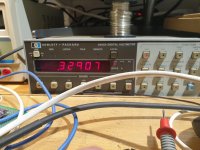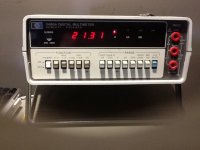JN,
Using a lathe will leave it out of round. (I know seems like a contradiction.) I would do it by hand rubbing it with a fine abrasive like jewelers rouge. You should be able to polish and rotate to keep things reasonably random. That assumes the problem is oversized and not out of round.
To fix out of round I would use a belt of very fine emery cloth, spinning it in the lathe. Centrifugal force should tend to round it.
Or you could spend ten bucks and get a new one.
What make lathe and mill?
As to Youngwood, do let me know a bit in advance, it takes a while to sharpen the dogs' teeth.
Using a lathe will leave it out of round. (I know seems like a contradiction.) I would do it by hand rubbing it with a fine abrasive like jewelers rouge. You should be able to polish and rotate to keep things reasonably random. That assumes the problem is oversized and not out of round.
To fix out of round I would use a belt of very fine emery cloth, spinning it in the lathe. Centrifugal force should tend to round it.
Or you could spend ten bucks and get a new one.
What make lathe and mill?
As to Youngwood, do let me know a bit in advance, it takes a while to sharpen the dogs' teeth.
Last edited:
Oh, you "just gotta" post a picture of those. My dad was a GE apprentice machinist graduate in the late 40's - I still have a few of the things he made in that course - but nothing like that!
Only some, others would probably violate forum rules. Be a while though...
I almost forgot that I have an HP3478A on my bench. I haven't used it for months. I usually use a good Fluke for most of my measurements, as it is more convenient.
When it comes to caps failing, it is my invaluable (to me) QuanTech noise analyzer that is the biggest problem I can never keep it working happily and easily, because some cap has gone south.
When it comes to caps failing, it is my invaluable (to me) QuanTech noise analyzer that is the biggest problem I can never keep it working happily and easily, because some cap has gone south.
I'm not as lucky; about 10 years ago, I had to replace all the electrolytics (lots of them!) and the nuvistor (with a JFet!). In the attached pic, all the blue stuff are my doing. Overall, the way the thing was built makes me think of a ... transistor radio. There goes the century old debate of HP vs Tek; and I'm a Tek guy 🙂.
LOLOL, poor you...NOT! lol, I am unable to discard old test equipment, it is a failing, I know...as a result I still have the Heathkit test eq I could afford as a teenager, then a generation of HP and Tek scopes and meters from the 1980s when I first started business (which worked the last time I used them), and now a 2000's-generation of Tek and HP stuff...I pity my wife when I pass...maybe I should start a museum.
On a day-to-day basis I use a Tek Spectrum Analyzer, Tek scope, an HP DVM, HP Freq counter and HP power supplies, so I like both, both great companies!
Cheers!
Howie
p.s. only some Heathkit was bought new...Tek & HP too rich new for me...
Hi Nelson! For sure, my HP3435A is still working and if I hadn't gotten a screaming deal on a recently calibrated HP34401A it would still be my go-to...they both give dead-reliable readings...My first decent multimeter was HP3435A. It's approaching 50 years on my
bench, and is still my favorite.
Cheers!
Howie
HP certainly made a lot of different bench multimeters in the old days. '-) Every one is slightly different. Power supplies too!
I'm with you, Howie. I have had to buy everything used, all my TEK, HP and even my Stanford Research SR-1, because it comes out of MY pocket. I recently hired a new tech, and she remarked how OLD my HP, etc equipment was. Only deep pockets can afford the latest, quality new stuff, but my lab works just fine for me, although I doubt that Richard Marsh would be happy with it.
Heathkit forever! (even EICO) '-)
I got excellent service from my old Heathkit stuff...with a 6" mirrored scale their VTVM (once stabilized) was very accurate...well repeatable would be more appropriate. since I did not have access to lab references when I was 14.
I started out in ham radio with an Eico transmitter I built...you remember Knight-Kits from Lafayette?
OK, back to the present.
Howie
I got excellent service from my old Heathkit stuff...with a 6" mirrored scale their VTVM (once stabilized) was very accurate...well repeatable would be more appropriate. since I did not have access to lab references when I was 14.
I started out in ham radio with an Eico transmitter I built...you remember Knight-Kits from Lafayette?
OK, back to the present.
Howie
If you looked at the 1.5 VDC scale just off the top was a small circle. That marked 1.56 volts. The actual voltage of a standard carbon-zinc cell when unloaded. That is how you were supposed to calibrate it! Of course the voltage divider resistors were only 5% tolerance thus limiting accuracy above that.
Knight Kits were from Allied Radio!
Funny, I'm a lot more attached to my Keithley benchtop and portable DVMs, than my HPs. In part that's because of all the great Keithley gear we used at Intel to characterize the "HMOS-II" process, the last and final generation of EDNMOS. Used on the 80286. Those Keithley's were rock solid and reliable. Don't know what happened to my Preparation HMOS T-shirt, which management tolerated with silent disapproval.
I blued it and tried to push it in. Quite round, marked the shaft uniformly. Was thinking just using the lathe to turn it, abrasive on the far end. Mount it using 3 jaw very gingerly with a .250 pin in it, using the live center on the end I want to reduce.JN,
Using a lathe will leave it out of round. (I know seems like a contradiction.) I would do it by hand rubbing it with a fine abrasive like jewelers rouge. You should be able to polish and rotate to keep things reasonably random. That assumes the problem is oversized and not out of round.
To fix out of round I would use a belt of very fine emery cloth, spinning it in the lathe. Centrifugal force should tend to round it.
Or you could spend ten bucks and get a new one.
What make lathe and mill?
As to Youngwood, do let me know a bit in advance, it takes a while to sharpen the dogs' teeth.
Hey, money is not the object...
Will give good notice, I assume it won't be until fall/winter the way things are going.
Jn
Ah, edit...Little machine shop , hitorque bench mill model 4190. 500 watt VSD, 11 by 5 by 10 volume, 3 DRO's.
Lathe model 5200 , 7 by 16, 500 watt VSD with DRO on rest and slide.
Baby machines, but I've a small basement, no access for larger.
Last edited:
I blued it and tried to push it in. Quite round, marked the shaft uniformly. Was thinking just using the lathe to turn it, abrasive on the far end. Mount it using 3 jaw very gingerly with a .250 pin in it, using the live center on the end I want to reduce.
Hey, money is not the object...
Will give good notice, I assume it won't be until fall/winter the way things are going.
Jn
It most likely is tempered and will not cut with a steel bit. Carbide would work, but an abrasive belt is best. BE SURE TO VACUUM UP ALL THE SWARF!
See most diligent folks just learned a new word!
It most likely is tempered and will not cut with a steel bit. Carbide would work, but an abrasive belt is best. BE SURE TO VACUUM UP ALL THE SWARF!
See most diligent folks just learned a new word!
They are hardened, I was thinking abrasive. But ya know, they want 6.95 for a new one, I would probably use more abrasive belt than that to take quarter mil off the shaft..have to buy something else though, flat rate shipping..
Jn
I just realized I have 3 6 1/2 digit bench meters I use and none are HP (Agilent, Keysight). I used to have an HP 3456 but replaced it with a Fluke 8506A for the thermal TRMS capability. Also a Prema 6001 and a Keithley 2015. All are pretty old by some standards but are all really stable and accurate. I found the Fluke to be substantially faster for most things than the HP and essentially SOTA even now for AC measurements. A Keysight 3458 would be a nice upgrade but I have lots of better things to do with that $5K used.
I still have a number of other older meters, HP3403C, Leader 2 channel voltmeter and Kenwood noise meter for example but rarely use them. However the moment they leave is when I need one for some obscure measurement.
I still have a number of other older meters, HP3403C, Leader 2 channel voltmeter and Kenwood noise meter for example but rarely use them. However the moment they leave is when I need one for some obscure measurement.
As to technical discussions on this thread
I think technical discussion died some time back.
...Knight Kits were from Allied Radio!
Of course! Thanks for the brain refresh...
Howie
- Home
- Member Areas
- The Lounge
- The Black Hole......

